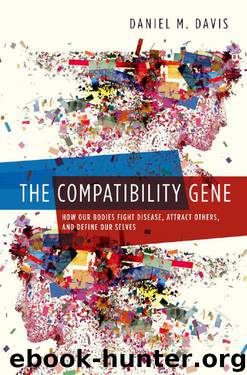The Compatibility Gene: How Our Bodies Fight Disease, Attract Others, and Define Our Selves by Daniel M. Davis

Author:Daniel M. Davis [Davis, Daniel M.]
Language: tur
Format: epub
Published: 2014-07-10T23:11:25+00:00
One reason why this is not guaranteed to work out is that there can
be great variety in the tumour cells themselves – even in a single
patient. Even within one person, individual cancer cells can vary in
115
The Compatibility Gene
their drug sensitivity. This situation is similar to what we saw with
HIV: a highly variable enemy is more difficult to attack.
Viruses and tumours do something else that’s a problem – they
actively thwart our defences. One way they do this is by trying to
prevent our compatibility genes from working. It’s a battle; our
immune system fights back by checking if compatibility genes have
been interfered with. This involves a whole other function of our
compatibility genes, a different way of looking at the immune system,
and another set of immune genes that are also extremely diverse
among us – in fact, they are probably only second to compatibility
genes in how variable they are from person to person. This next piece
of the canvas – hard-won by new heroes – reveals how compatibility
genes can work in the exact opposite way to what we’ve discussed so far. Breathe it all in, embrace the complexity.
116
7
Missing Self
Klas Kärre would later chair the committee that decides the Nobel
Prize in Physiology or Medicine, but in 1981, while writing his PhD
thesis, he was less secure. Trying to summarize his observations in the
last chapter of his thesis, he was puzzled by some data that didn’t
seem consistent with the prevailing ideas about how the immune sys-
tem worked. Kärre – described by his PhD supervisor, Rolf Kiessling,
as soft-spoken, eloquent and slightly absent-minded1 – thought about the problem a lot. Others had come across the same discrepancies but
just didn’t think them particularly important. What often distin-
guishes the great from the everyday scientists is their ability to think
lucidly about observations that don’t fit with contemporary paradigms.
As Leonard Cohen sings, ‘There is a crack in everything, that’s how
the light gets in. ’2
Once again, experiments in transplantation were at the heart of the
matter. Recall that a transplant is rejected whenever it has proteins
detected as non-self which cause an immune attack. But there was an
exception to this rule – first observed in the 1950s by George Snell,
working in the Jackson Laboratory, Maine, USA, a small, independ-
ent non-profit research institution. He discovered a situation in which
transplants would be rejected even when they didn’t have non-self
proteins.
To understand the mystery – to think about it deeply like Kärre
did – we need to consider the genetics of the inbred mice used in
Snell’s experiments. Inbred mice are obtained by successive breeding
between siblings (or parents and their offspring) over long periods. 3
Offspring from two different types of inbred mice are called the
F1 hybrid. Not the cutest of baby names, it stands for Filial 1 hybrid 117
The Compatibility Gene
and is a widely used genetic term to describe offspring from different
strains of animals or plants. For example, a mule is the F1 hybrid of a
male donkey and a female horse. That is, a mule came about when a
donkey and horse mated rather than being a species that evolved
through gradual changes in an ancestor of all three animals.
Download
This site does not store any files on its server. We only index and link to content provided by other sites. Please contact the content providers to delete copyright contents if any and email us, we'll remove relevant links or contents immediately.
Periodization Training for Sports by Tudor Bompa(8168)
Why We Sleep: Unlocking the Power of Sleep and Dreams by Matthew Walker(6618)
Paper Towns by Green John(5087)
The Immortal Life of Henrietta Lacks by Rebecca Skloot(4525)
The Sports Rules Book by Human Kinetics(4290)
Dynamic Alignment Through Imagery by Eric Franklin(4116)
ACSM's Complete Guide to Fitness & Health by ACSM(3987)
Kaplan MCAT Organic Chemistry Review: Created for MCAT 2015 (Kaplan Test Prep) by Kaplan(3939)
Introduction to Kinesiology by Shirl J. Hoffman(3721)
Livewired by David Eagleman(3682)
The Death of the Heart by Elizabeth Bowen(3551)
The River of Consciousness by Oliver Sacks(3536)
Alchemy and Alchemists by C. J. S. Thompson(3448)
Bad Pharma by Ben Goldacre(3354)
Descartes' Error by Antonio Damasio(3229)
The Emperor of All Maladies: A Biography of Cancer by Siddhartha Mukherjee(3063)
The Gene: An Intimate History by Siddhartha Mukherjee(3046)
The Fate of Rome: Climate, Disease, and the End of an Empire (The Princeton History of the Ancient World) by Kyle Harper(3003)
Kaplan MCAT Behavioral Sciences Review: Created for MCAT 2015 (Kaplan Test Prep) by Kaplan(2936)
